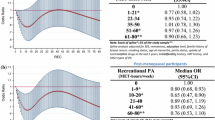Abstract
We examined the relation between physical activity and endometrial cancer using data from a multicentre case-control study involving 405 endometrial cancer cases and 297 population controls. Estimates of recreational (i.e. active sport, walks and hikes) and nonrecreational activity (i.e. house cleaning, climbing stairs and walking or standing on the job) were obtained using interview information. After adjustment for age, study area, education, parity, years of use of oral contraceptives, years of use of menopausal oestrogens and cigarette smoking, recent recreational inactivity was associated with increased risk (RR = 1.9 for lowest vs highest tertile). Similarly, recent nonrecreational inactivity was associated with increased risk (RR = 2.2 for lowest vs highest tertile). Further adjustment for body mass and nonrecreational activity attenuated the association between risk and recent recreational inactivity (RR = 1.2; 95% CL = 0.7-2.0) but adjustment for body mass and recreational activity did not alter the association between risk and recent nonrecreational inactivity (RR = 2.0; 95% CL = 1.2-3.1). To evaluate the relation between risk and sustained inactivity, we simultaneously examined activity levels at three periods (RR i.e. age 20-29, age 30-39 and recently) in women age 50 and older. After adjustment for potential confounders and body mass, risk was elevated among women who were always recreationally inactive (RR = 1.5 for always active vs always inactive) and among women who were always nonrecreationally inactive (RR = 1.6 for always active vs always inactive). This study suggests that physically inactive women may be at increased risk of endometrial cancer because they are more likely to be overweight or obese. Our data also suggest that inactivity per se may be associated with an increased risk of endometrial cancer. However, we cannot rule out the possibility that our results, particularly those for nonrecreational activity, reflect unmeasured confounding factors. Future studies should attempt to obtain more detailed assessments of physical activity, including the intensity with which an individual engaged in an activity and the actual time involved in exertion.
Similar content being viewed by others
Author information
Authors and Affiliations
Rights and permissions
About this article
Cite this article
Sturgeon, S., Brinton, L., Berman, M. et al. Past and present physical activity and endometrial cancer risk. Br J Cancer 68, 584–589 (1993). https://doi.org/10.1038/bjc.1993.390
Issue Date:
DOI: https://doi.org/10.1038/bjc.1993.390
- Springer Nature Limited
This article is cited by
-
A systematic review and meta-analysis of physical activity and endometrial cancer risk
European Journal of Epidemiology (2015)
-
Long-term and baseline recreational physical activity and risk of endometrial cancer: the California Teachers Study
British Journal of Cancer (2013)
-
High rates of endometrial cancer among Pacific women in New Zealand: the role of diabetes, physical inactivity, and obesity
Cancer Causes & Control (2012)
-
Case–control study of lifetime total physical activity and endometrial cancer risk
Cancer Causes & Control (2010)
-
Prävention des Endometriumkarzinoms
Der Gynäkologe (2008)




